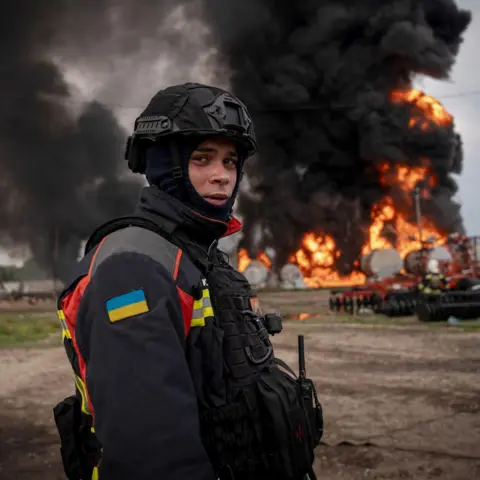 Valeria Demenko/DSNS
Valeria Demenko/DSNSWithin the 3 years since Russia introduced its full-scale invasion of Ukraine, masses of photographers have documented the human have an effect on of the warfare at the entrance series and in civilian subjects.
A few of them have shared tales about their pictures that have gave the impression in BBC protection since February 2022.
Vlada and Kostiantyn Liberov
Previous to the full-scale warfare, this husband and spouse group labored as wedding ceremony and portrait photographers within the Dark Sea port town of Odesa. They quickly moved “from capturing love stories, to documenting Russian war crimes”, remembers Vlada.
She is aware of first-hand the hazards in her paintings. An explosion on a seek advice from to the Donetsk patch in 2023 left her with shrapnel lodged deep in her aspect, which docs determined may now not be got rid of.
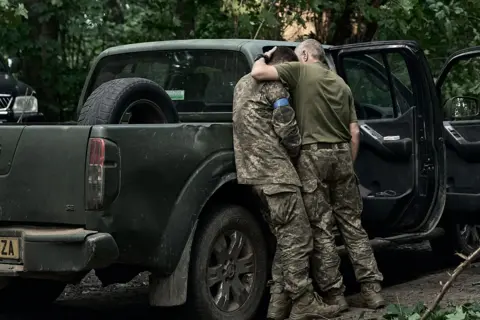 Kostiantyn Liberov/Libkos by the use of Getty Photographs
Kostiantyn Liberov/Libkos by the use of Getty PhotographsThis robust shot taken by means of Kostiantyn Liberov in the summertime of 2024 was once featured in Paul Adams’ document at the Ukrainian offensive over the Russian border in Kursk.
A soldier is evident consoling his determined comrade next getting back from an attack by which a fellow serviceman was once killed.
For Liberov, the picture mirrors probably the most dubiousness throughout the army over the operation.
“To lose your friend in an attack inside Russia, rather than defending our country in Ukraine, is very difficult,” he mentioned. “I took this photo because of the emotional impact it had on me. It says a lot about the situation and how hard it was for them.”
Photographing such deeply affecting scenes has taken its toll on native photojournalists. “It’s not something we talk about a lot with colleagues as it’s painful,” says Vlada. “You are in a very hard situation, and no-one quite understands what the solution can be.”
One 2023 photograph of hers captures a member of Ukraine’s White Angels police unit next an unsuccessful struggle to persuade one of the crucial endmost excess citizens to release the japanese town of Aviidvka earlier than Russian forces sweep in.
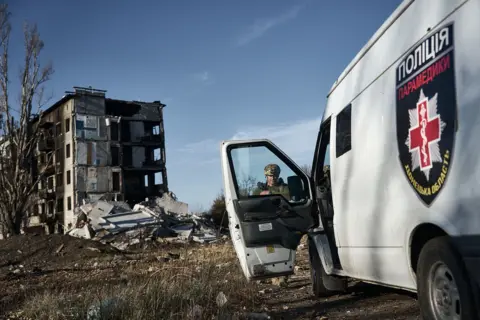 Vlada Liberov/Libkos by the use of Getty Photographs
Vlada Liberov/Libkos by the use of Getty PhotographsThe tale was once a part of a BBC article on a fatal 24-hour Russian bombardment.
A person had requested the police unit to evacuate his brother from the basement of a burnt out development, and but he nonetheless refused to release.
“The next day we could not return because of hard shelling,” Vlada recalls. “The situation got much worse and I’m not sure he could have survived. It hurts knowing you cannot return to these places.”
In documenting such a lot loss and struggling, the couple have discovered a deeper respect of moments of pleasure.
Dmytro, who has fought in Ukraine for greater than a decade, was once photographed next his spouse gave beginning in March 2024.
“We used to take photos of him in the trenches. And then you see this big, brave soldier crying while he takes his small daughter in his hands, and you understand soldiers like him fight for these moments. Not just for themselves, but for everyone in Ukraine.”
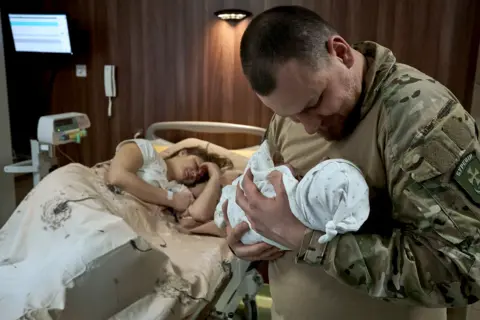 Kostiantyn Liberov/Libkos by the use of Getty Photographs
Kostiantyn Liberov/Libkos by the use of Getty PhotographsValeria Demenko
Since 2016, Valeria Demenko has chronicled the paintings of Ukraine’s atmosphere catastrophe provider (DSNS) within the north-eastern Sumy patch, and she or he now joins rescue groups deployed to subjects accident by means of Russian shelling.
“It’s always difficult… you never know what danger awaits you. It is especially difficult when residential buildings come under attack”.
One generation engraved on her reminiscence concerned a hanging symbol featured in a tale in March 2024 appearing catastrophe employees on the scene of a five-storey development that collapsed next Russian shelling, with citizens nonetheless inside of.
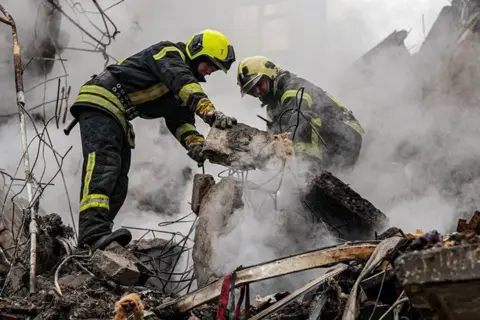 Valeria Demenko/DSNS
Valeria Demenko/DSNSValeria remembers how catastrophe employees attended the website online for 4 days directly. They discovered 4 lifeless, however by no means recovered the frame of a lacking woman.
“There was a doll on one of the upper floors… it meant a child was living there, and there may have been more.”
Even supposing all her colleagues are emotionally stretched, she needs the sector to look their paintings: “We give every last ounce of strength to document Russia’s crimes against peaceful Ukrainians.”
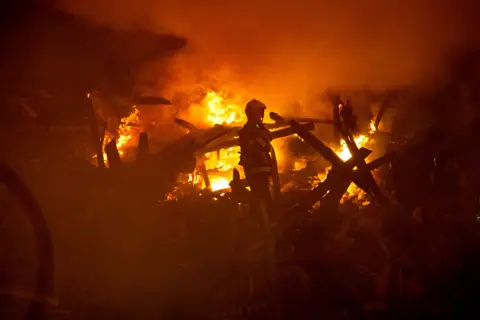 Valeria Demenko/DSNS
Valeria Demenko/DSNSAlexander Ermochenko
Alexander Ermochenko has spent the generation 11 years documenting Ukraine’s warfare as a photojournalist within the japanese Donetsk patch.
He has ceaselessly reported in Russian-controlled area too and “never thought I’d be photographing war in my home”.
“The fear on the face of the owner of a destroyed house is the same on both sides of the front. It is always important to show that blood has the same red colour.”
The BBC has much less get admission to to photojournalists reporting from Russia, because the Kremlin restricts get admission to to global newshounds and Russian information businesses are in large part state-run.
The BBC approached a Russia-based photographer to give a contribution to this tale however gained negative reaction.
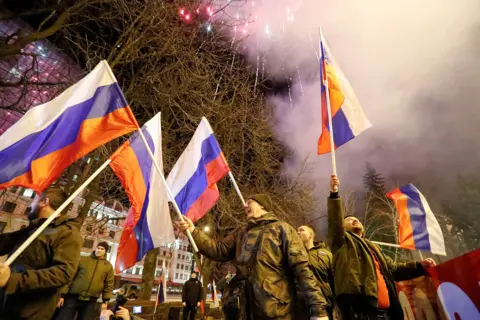 Alexander Ermochenko/Reuters
Alexander Ermochenko/ReutersWithin the above image, Ermochenko captured jubilant pro-Russian activists on 21 February 2022 next Vladimir Putin declared their japanese patch free. It was once revealed as a part of the BBC’s protection of that fateful generation.
He describes how the photograph happened “accidentally” – an impressive reminder of the prospective have an effect on of a photographer’s split-second choice to boost their digicam.
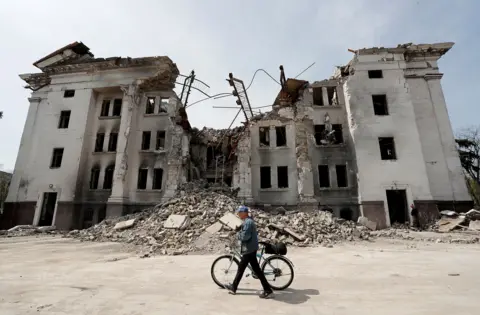 Alexander Ermochenko/Reuters
Alexander Ermochenko/ReutersUkraine mentioned 300 family had been killed when Russian planes bombed Mariupol theatre in March 2022.
Please see occasion, Alexander Ermochenko captured this symbol, featured in Hugo Bachega’s document, by which the photographer conveys the aftermath of a bloodbath along on a regular basis while.
“The destruction was absolute,” he recalls, “with destroyed nine-storey buildings looking like a Hollywood set. But they are real, and recently inhabited by people.”
“What was most surprising was that life continued, despite the fighting in neighbouring streets. People looked calm, but in fact they were deeply shocked by what was happening.”
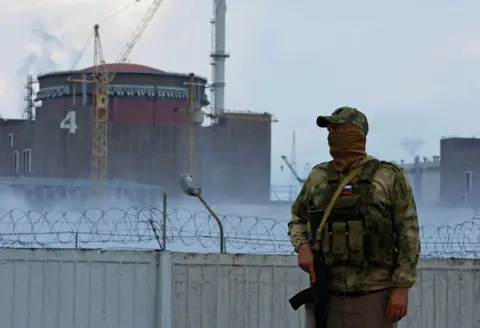 Alexander Ermochenko/Reuters
Alexander Ermochenko/ReutersThis photograph, worn in our reside reporting of the Zaporizhzhia nuclear plant shelling in November 2022, illustrates the trouble in photographing the warfare.
“Pictures of the plant were rare at that time,” says Ermochenko. “It is constantly under guard, though the soldiers themselves perfectly illustrate the situation.”
In spite of the demanding situations he and his colleagues face, he says “the war is not only a part of my professional career, but a big part of my whole life… no matter how difficult it is, I will continue.”
Alina Smutko
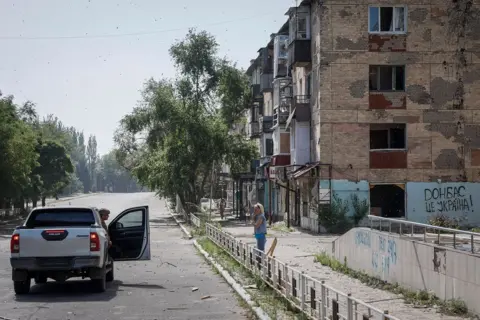 Alina Smutko/Reuters
Alina Smutko/ReutersBased totally in Kyiv, Alina Smutko understands the human have an effect on of this warfare via her paintings as a photojournalist and from non-public enjoy.
“I’ve experienced Russian missiles and drone attacks on the city almost non-stop for three years. During this time, I’ve been constantly worried about my parents, child, friends and colleagues.”
She feels fortunate that her house is undamaged and her family members alive, next witnessing a missile assault on her neighbourhood from her bed room window.
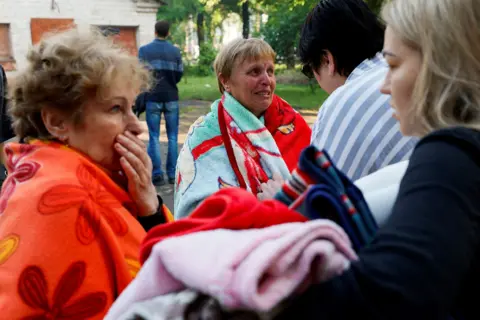 Alina Smutko/Reuters
Alina Smutko/ReutersTo start with, she and her buddies and crowd would take a look at in with each and every alternative every day next the full-scale Russian invasion.
However the frequency of assaults has compelled citizens to learn how to reside with the warfare and conserve as commonplace a while as conceivable.
The toll on her career has been crispy.
“We see how our colleagues – photojournalists in particular – were killed or wounded during this invasion. We lost one of our team members, and another colleague has been badly wounded.”
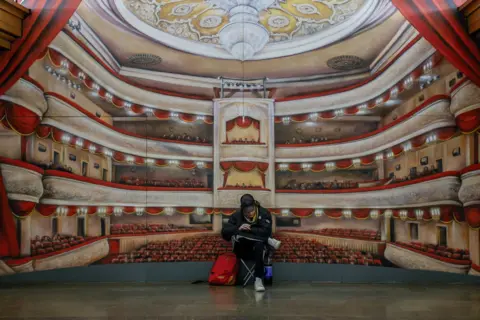 Alina Smutko/Reuters
Alina Smutko/ReutersSmutko tries to not “overthink” what she does, however believes it’s notable to percentage the consequences of the warfare with the sector.
“I think it helps somehow, but I don’t believe in the idea that a picture can stop a war. If it could, we would not have lost so many lives here.”
“I still believe that documenting is important. Because if something hasn’t been photographed, it hasn’t happened.”
“This work has to be done… I just do my best.”
Lead symbol displays a member of the catastrophe services and products attending a hearth as a result of a Russian clash on a fuel vault, alike the border in north-eastern Sumy in Might 2024.
